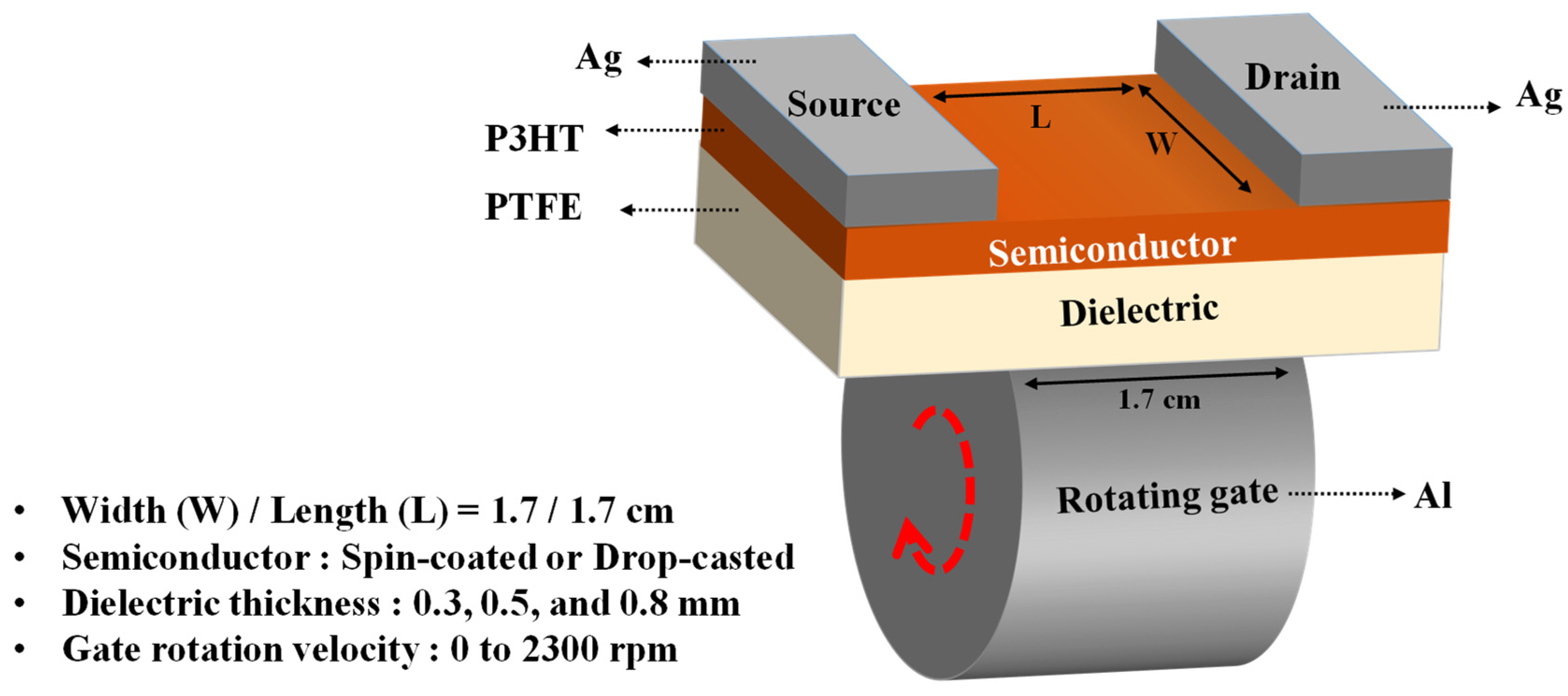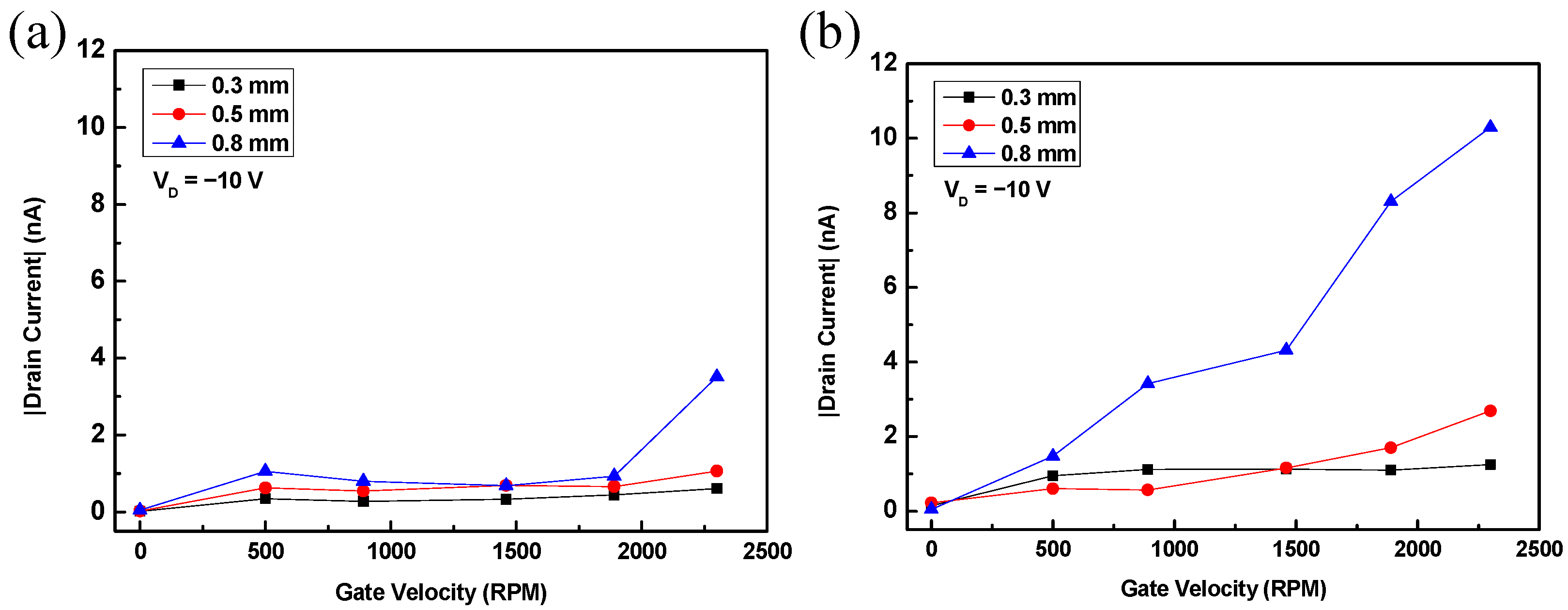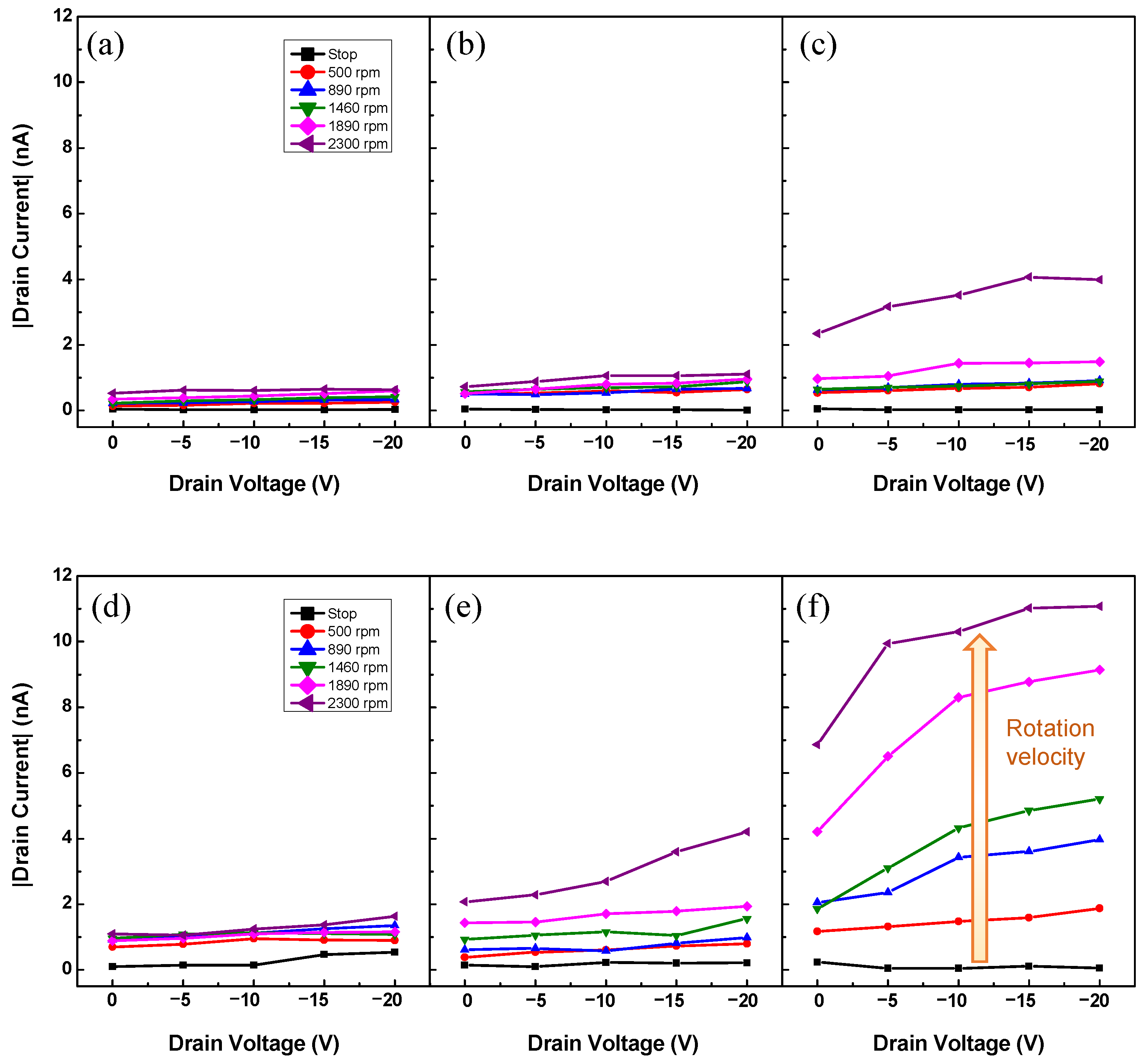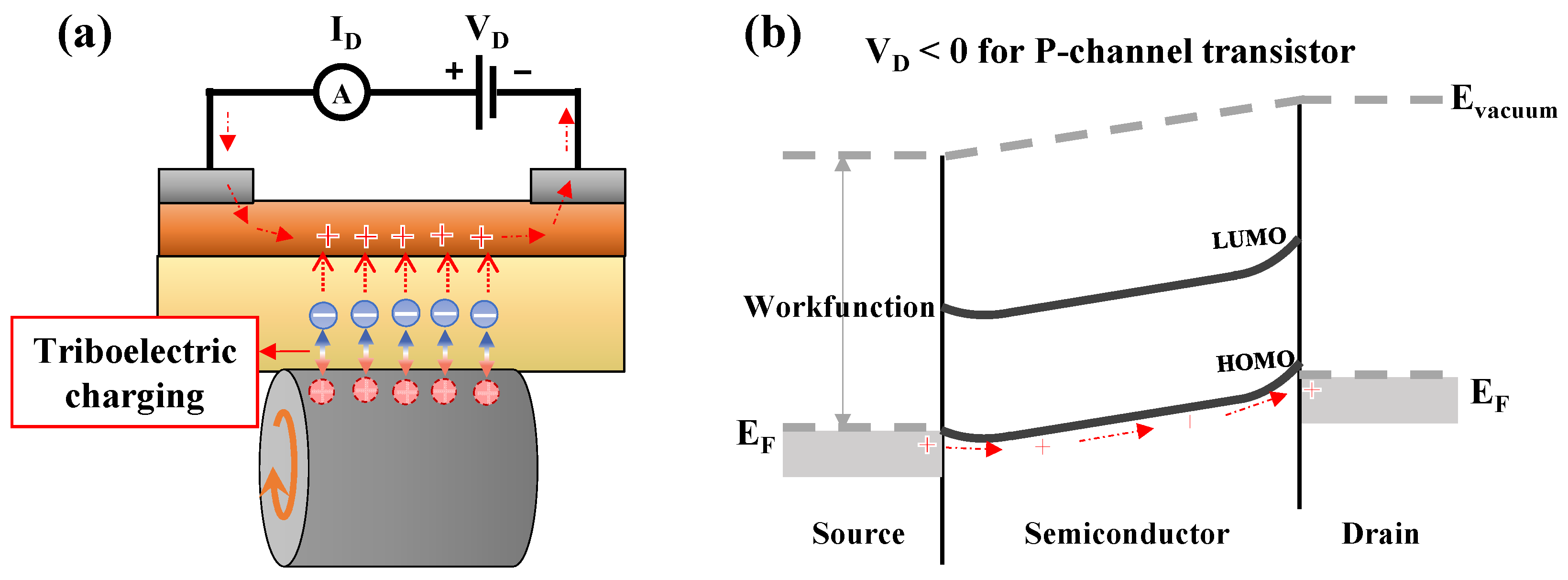Rotating Gate-Driven Solution-Processed Triboelectric Transistors
Abstract
:1. Introduction
2. Experimental Details
3. Results and Discussion
4. Conclusions
Author Contributions
Funding
Institutional Review Board Statement
Informed Consent Statement
Data Availability Statement
Conflicts of Interest
References
- İnci, M.; Büyük, M.; Demir, M.H.; İlbey, G. A review and research on fuel cell electric vehicles: Topologies, power electronic converters, energy management methods, technical challenges, marketing and future aspects. Renew. Sust. Energ. Rev. 2021, 137, 110648. [Google Scholar] [CrossRef]
- Guerrero-Ibáñez, J.; Zeadally, S.; Contreras-Castillo, J. Sensor technologies for intelligent transportation systems. Sensors 2018, 18, 1212. [Google Scholar] [CrossRef] [PubMed] [Green Version]
- Kwak, S.S.; Yoon, H.J.; Kim, S.W. Textile-based triboelectric nanogenerators for self-powered wearable electronics. Adv. Funct. Mater. 2019, 29, 1804533. [Google Scholar] [CrossRef]
- Rong, G.; Zheng, Y.; Sawan, M. Energy solutions for wearable sensors: A review. Sensors 2021, 21, 3806. [Google Scholar] [CrossRef]
- Dolez, P.I. Energy Harvesting Materials and Structures for Smart Textile Applications: Recent Progress and Path Forward. Sensors 2021, 21, 6297. [Google Scholar] [CrossRef] [PubMed]
- Askari, H.; Khajepour, A.; Khamesee, M.B.; Wang, Z.L. Embedded self-powered sensing systems for smart vehicles and intelligent transportation. Nano Energy 2019, 66, 104103. [Google Scholar] [CrossRef]
- Hjelme, D.; Bjerkan, L.; Neegard, S.; Rambech, J.; Aarsnes, J. Application of Bragg grating sensors in the characterization of scaled marine vehicle models. Appl. Opt. 1997, 36, 328–336. [Google Scholar] [CrossRef]
- Guo, T.; Zhao, J.; Liu, W.; Liu, G.; Pang, Y.; Bu, T.; Xi, F.; Zhang, C.; Li, X. Self-powered hall vehicle sensors based on triboelectric nanogenerators. Adv. Mater. Technol. 2018, 3, 1800140. [Google Scholar] [CrossRef]
- Lin, L.; Hu, Y.; Xu, C.; Zhang, Y.; Zhang, R.; Wen, X.; Wang, Z.L. Transparent flexible nanogenerator as self-powered sensor for transportation monitoring. Nano Energy 2013, 2, 75–81. [Google Scholar] [CrossRef]
- Rui, X.; Zeng, Z.; Zhang, Y.; Li, Y.; Feng, H.; Huang, X.; Sha, Z. Design and experimental investigation of a self-tuning piezoelectric energy harvesting system for intelligent vehicle wheels. IEEE Trans. Veh. Technol. 2019, 69, 1440–1451. [Google Scholar] [CrossRef]
- Nie, J.; Ren, Z.; Shao, J.; Deng, C.; Xu, L.; Chen, X.; Li, M.; Wang, Z.L. Self-powered microfluidic transport system based on triboelectric nanogenerator and electrowetting technique. Acs Nano 2018, 12, 1491–1499. [Google Scholar] [CrossRef]
- Aliverdiev, A.; Caponero, M.; Moriconi, C. Speckle velocimeter for a self-powered vehicle. Tech. Phys. 2002, 47, 1044–1048. [Google Scholar] [CrossRef]
- Fan, F.-R.; Tian, Z.-Q.; Wang, Z.L. Flexible triboelectric generator. Nano Energy 2012, 1, 328–334. [Google Scholar] [CrossRef]
- Yair, Y. Charge generation and separation processes. Space Sci. Rev. 2008, 137, 119–131. [Google Scholar] [CrossRef]
- Zhu, G.; Lin, Z.-H.; Jing, Q.; Bai, P.; Pan, C.; Yang, Y.; Zhou, Y.; Wang, Z.L. Toward large-scale energy harvesting by a nanoparticle-enhanced triboelectric nanogenerator. Nano Lett. 2013, 13, 847–853. [Google Scholar]
- Quan, T.; Wang, X.; Wang, Z.L.; Yang, Y. Hybridized electromagnetic–triboelectric nanogenerator for a self-powered electronic watch. Acs Nano 2015, 9, 12301–12310. [Google Scholar] [CrossRef]
- Yang, Y.; Zhang, H.; Wang, Z.L. Direct-current triboelectric generator. Adv. Funct. Mater. 2014, 24, 3745–3750. [Google Scholar] [CrossRef]
- Liu, B.; Libanori, A.; Zhou, Y.; Xiao, X.; Xie, G.; Zhao, X.; Su, Y.; Wang, S.; Yuan, Z.; Duan, Z. Simultaneous Biomechanical and Biochemical Monitoring for Self-Powered Breath Analysis. ACS Appl. Mater. Interfaces 2022, 14, 7301–7310. [Google Scholar]
- Liang, Q.; Yan, X.; Gu, Y.; Zhang, K.; Liang, M.; Lu, S.; Zheng, X.; Zhang, Y. Highly transparent triboelectric nanogenerator for harvesting water-related energy reinforced by antireflection coating. Sci. Rep. 2015, 5, 1–7. [Google Scholar] [CrossRef] [Green Version]
- Constantinou, M.; Caccese, J.; Harris, H.G. Frictional characteristics of Teflon–steel interfaces under dynamic conditions. Earthq. Eng. Struct. Dyn. 1987, 15, 751–759. [Google Scholar] [CrossRef]
- Parshintsev, J.; Ruiz-Jimenez, J.; Petäjä, T.; Hartonen, K.; Kulmala, M.; Riekkola, M.-L. Comparison of quartz and Teflon filters for simultaneous collection of size-separated ultrafine aerosol particles and gas-phase zero samples. Anal. Bioanal. Chem. 2011, 400, 3527–3535. [Google Scholar] [PubMed]
- Peng, H.; Ren, H.; Dang, M.; Zhang, Y.; Yao, X.; Lin, H. Novel high dielectric constant and low loss PTFE/CNT composites. Ceram. Int. 2018, 44, 16556–16560. [Google Scholar]
- Kim, C.S.; Jo, S.J.; Lee, S.W.; Kim, W.J.; Baik, H.K.; Lee, S.J.; Hwang, D.; Im, S. High-k and low-k nanocomposite gate dielectrics for low voltage organic thin film transistors. Appl. Phys. Lett. 2006, 88, 243515. [Google Scholar] [CrossRef]
- Veres, J.; Ogier, S.D.; Leeming, S.W.; Cupertino, D.C.; Mohialdin Khaffaf, S. Low-k insulators as the choice of dielectrics in organic field-effect transistors. Adv. Funct. Mater. 2003, 13, 199–204. [Google Scholar]
- Peng, W.; Yu, R.; He, Y.; Wang, Z.L. Theoretical study of triboelectric-potential gated/driven metal–oxide–semiconductor field-effect transistor. ACS Nano 2016, 10, 4395–4402. [Google Scholar] [CrossRef]
- Zhao, L.; Guo, J.; Liu, L.; Zhang, S.; Gao, Y.; Yang, F.; Gan, J.; Gu, G.; Zhang, B.; Cui, P. The triboelectric microplasma transistor of monolayer graphene with a reversible oxygen ion floating gate. Nano Energy 2020, 78, 105229. [Google Scholar] [CrossRef]
- Zhao, L.; Chen, K.; Yang, F.; Zheng, M.; Guo, J.; Gu, G.; Zhang, B.; Qin, H.; Cheng, G.; Du, Z. The novel transistor and photodetector of monolayer MoS2 based on surface-ionic-gate modulation powered by a triboelectric nanogenerator. Nano Energy 2019, 62, 38–45. [Google Scholar]
- Qu, W.; Liu, W.; Li, X.; Wang, X. A triboelectric charge top-gated graphene transistor. Diam. Relat. Mater. 2017, 73, 33–38. [Google Scholar]
- Wang, Z.; Huang, L.; Chi, L. Organic semiconductor field-effect transistors based on organic-2D heterostructures. Front. Mater. 2020, 7, 295. [Google Scholar] [CrossRef]
- Snyder, C.R.; DeLongchamp, D.M. Glassy phases in organic semiconductors. Curr. Opin. Solid State Mater. Sci. 2018, 22, 41–48. [Google Scholar] [CrossRef]
- Pal, T.; Arif, M.; Khondaker, S.I. High performance organic phototransistor based on regioregular poly (3-hexylthiophene). Nanotechnology 2010, 21, 325201. [Google Scholar] [CrossRef]
- Zhang, Z.; Sun, X.; Chen, Y.; Debeli, D.K.; Guo, J. Comprehensive dependence of triboelectric nanogenerator on dielectric thickness and external impact for high electric outputs. J. Appl. Phys. 2018, 124, 045106. [Google Scholar] [CrossRef]
- Zhang, Y.; Li, H.; Wang, H.; Xie, H.; Liu, R.; Zhang, S.-L.; Qiu, Z.-J. Thickness Considerations of Two-Dimensional Layered Semiconductors for Transistor Applications. Sci. Rep. 2016, 6, 29615. [Google Scholar] [CrossRef]
- Kim, D.-H.; Cha, H.-S.; Jeong, H.-S.; Hwang, S.-H.; Kwon, H.-I. Effects of Active Layer Thickness on the Electrical Characteristics and Stability of High-Mobility Amorphous Indium–Gallium–Tin Oxide Thin-Film Transistors. Electronics 2021, 10, 1295. [Google Scholar] [CrossRef]
- Dodabalapur, A.; Torsi, L.; Katz, H.E. Organic Transistors: Two-Dimensional Transport and Improved Electrical Characteristics. Science 1995, 268, 270–271. [Google Scholar] [CrossRef]
- Li, J.; Ding, X.-W.; Zhang, J.-H.; Zhang, H.; Jiang, X.-Y.; Zhang, Z.-L. Improving electrical performance and bias stability of HfInZnO-TFT with optimizing the channel thickness. Aip Adv. 2013, 3, 102132. [Google Scholar] [CrossRef]
- Klauk, H. Organic thin-film transistors. Chem. Soc. Rev. 2010, 39, 2643–2666. [Google Scholar] [CrossRef]
- Diaz, A.; Felix-Navarro, R. A semi-quantitative tribo-electric series for polymeric materials: The influence of chemical structure and properties. J. Electrostat. 2004, 62, 277–290. [Google Scholar] [CrossRef]
- Shin, H.; Kim, D.; Park, J.; Song, S.-H.; Choi, J.S. Capillary-Force-Pattern Formation of Indium-Zinc-Oxide Thin-Film Transistor. J. Nanosci. Nanotechnol. 2019, 19, 2179–2182. [Google Scholar] [CrossRef]
- Liu, J.; Liu, F.; Bao, R.; Jiang, K.; Khan, F.; Li, Z.; Peng, H.; Chen, J.; Alodhayb, A.; Thundat, T. Scaled-up direct-current generation in MoS2 multilayer-based moving heterojunctions. ACS Appl. Mater. Interfaces 2019, 11, 35404–35409. [Google Scholar] [CrossRef]
- Kim, D.W.; Lee, J.H.; You, I.; Kim, J.K.; Jeong, U. Adding a stretchable deep-trap interlayer for high-performance stretchable triboelectric nanogenerators. Nano Energy 2018, 50, 192–200. [Google Scholar] [CrossRef]
- Singh, B.; Mehta, B. Relationship between nature of metal-oxide contacts and resistive switching properties of copper oxide thin film based devices. Thin Solid Films 2014, 569, 35–43. [Google Scholar] [CrossRef]
- Xu, B.; Sai-Anand, G.; Gopalan, A.-I.; Qiao, Q.; Kang, S.-W. Improving photovoltaic properties of P3HT: IC60BA through the incorporation of small molecules. Polymers 2018, 10, 121. [Google Scholar] [CrossRef] [PubMed] [Green Version]
- Youxian, D.; Griesser, H.J.; Mau, A.W.-H.; Schmidt, R.; Liesegang, J. Surface modification of poly (tetrafluoroethylene) by gas plasma treatment. Polymer 1991, 32, 1126–1130. [Google Scholar] [CrossRef]
- Fan, C.-L.; Yang, T.-H.; Chiu, P.-C. Performance improvement of bottom-contact pentacene-based organic thin-film transistors by inserting a thin polytetrafluoroethylene buffer layer. Appl. Phys. Lett. 2010, 97, 219. [Google Scholar] [CrossRef]
- Brixi, S.; Melville, O.A.; Boileau, N.T.; Lessard, B.H. The influence of air and temperature on the performance of PBDB-T and P3HT in organic thin film transistors. J. Mater. Chem. C 2018, 6, 11972–11979. [Google Scholar] [CrossRef]
- Liu, C.-C.; Yang, C.-M.; Liu, W.-H.; Liao, H.-H.; Horng, S.-F.; Meng, H.-F. Interface effect of oxygen doping in polythiophene. Synth. Met. 2009, 159, 1131–1134. [Google Scholar] [CrossRef]
- Kim, J.; Kim, H.; Kim, S.H.; Park, C.E. (Poly (3, 4-ethylenedioxythiophene): Polystyrene sulfonate): Polytetrafluoroethylene for use in high-performance and stable bottom-contact organic field-effect transistors. J. Phys. Chem. C 2016, 120, 956–962. [Google Scholar] [CrossRef]
- Paramo-Balsa, P.; Roldan-Fernandez, J.M.; Burgos-Payan, M.; Riquelme-Santos, J.M. A Low-Cost Non-Intrusive Method for In-Field Motor Speed Measurement Based on a Smartphone. Sensors 2021, 21, 4317. [Google Scholar] [CrossRef]






Publisher’s Note: MDPI stays neutral with regard to jurisdictional claims in published maps and institutional affiliations. |
© 2022 by the authors. Licensee MDPI, Basel, Switzerland. This article is an open access article distributed under the terms and conditions of the Creative Commons Attribution (CC BY) license (https://creativecommons.org/licenses/by/4.0/).
Share and Cite
Shin, H.; Kim, D.Y. Rotating Gate-Driven Solution-Processed Triboelectric Transistors. Sensors 2022, 22, 3309. https://doi.org/10.3390/s22093309
Shin H, Kim DY. Rotating Gate-Driven Solution-Processed Triboelectric Transistors. Sensors. 2022; 22(9):3309. https://doi.org/10.3390/s22093309
Chicago/Turabian StyleShin, Hyunji, and Dae Yu Kim. 2022. "Rotating Gate-Driven Solution-Processed Triboelectric Transistors" Sensors 22, no. 9: 3309. https://doi.org/10.3390/s22093309





